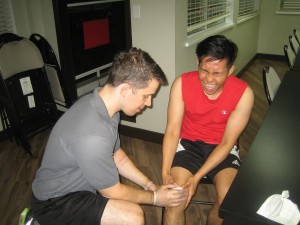Always bear in mind that indoor cycling is widely used as a way for many individuals to stay fit while at home. When it comes to indoor cycling, a stationary bike provides an intense cardiovascular workout and capable of burning 400-500 calories during a 45-60 minute session.
Using a stationary bike provides a low impact workout. The individual can work out at his/her own pace and steadily build up to a more challenging routine. On the other hand, just like with any activity, if it is executed incorrectly, too vigorously or too often, it can lead to injuries. Always bear in mind that the knees, back and hips are highly susceptible to injuries while indoor cycling using a stationary bike.
Knee injuries
Due to the constant movement required in cycling, knee injuries can occur. This can be triggered by overuse or not setting the seat properly. While pedaling, it is vital to set the seat height so that there is a slight bend in the knee when the foot and pedal is at the bottom position.

The seat must be forward enough so that the knee is over the middle of the pedal. Always bear in mind that an incorrect bicycle configuration and riding form can cause the ligaments and tendons to become pulled, overstretched or tight. A usual injury is patellar tendinitis which involves chronic inflammation of the tendon that connects the patella to the shinbone.
Back injuries
Due to incorrect posture while using a stationary bike such as hunching the shoulders, leaning forward or leaning too far from side to side, it can lead to strained back muscles. The ligaments and tendons can end up irritated and might add pressure on the discs. In addition, the back muscles become tight. Remember that all of these can eventually lead to chronic back pain.
Hip injuries
Strenuous cycling and incorrect bike usage can also lead to hip issues. The repetitive forward movement while using a stationary bike can cause the piriformis muscle to tighten which adds pressure on the sciatic nerve. In addition, since cycling is mainly a forward motion, the interior and exterior thigh muscles can end up weak and deconditioned which leads to muscular imbalance. In most cases, the individual might end up with pain in the buttocks that can radiate down the hips and legs.
Wrist injuries
Since indoor cycling is considered as an intense workout, the individual becomes tired and tends to lean heavily on the handlebars which strains on the wrists. The individual should focus on allowing the abdominal muscles and legs to keep him/her up. If possible, put as little weight on the wrists and hands while riding. In case the wrists are damaged, they can become sore or there is tingling or numbing sensation in the hands, wrist or fingers.
Management and prevention
Injuries while indoor cycling can be avoided. The individual can consult an instructor to ensure that the bike is configured correctly. It is recommended to stretch the leg and back muscles after every ride. In addition, cross training using other cardiovascular activities can help cut down the risk for overuse issues. Strength training exercises that focuses on the leg and core muscles can also help avoid muscular imbalance as well as help the individual ride correctly.
